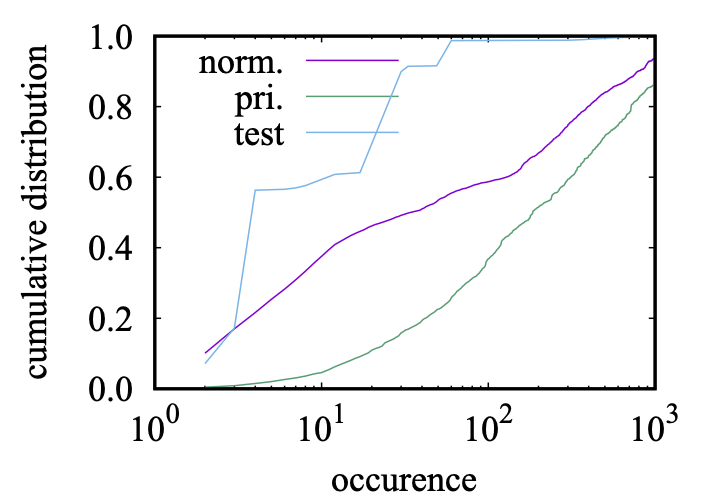Documents on test delivery for QZSS's disaster and crisis management report
Disaster and crisis management report
The quasi-zenith satellite (Michibiki) broadcasts information on disasters as well as positioning augmentation information on the L1S channel. Anyone can decode this disaster and crisis management report (DCR) for free. Since we do not know when a disaster will occur, we are conducting a test delivery of predetermined contents around the 4th Thursday of every month.
I am interested in and analyzing this DCR message and signal format.
For example, in the free-text “Nankai Trough Earthquake” scenario included in this test, messages are transmitted over a long period of time because every 6 Kanji Japanese characters are sent in 63 messages. The test delivery consists of all 11 scenarios. Except for the Nankai Trough earthquake scenario, the delivery is 5 minutes, while the Nankai Trough earthquake scenario is a 20-minute delivery.

This figure shows how many times the same message was broadcast repeatedly during the one-year DCR message observation from September 1, 2020 to August 31, 2021. The horizontal axis shows the number of same message retransmissions, and the vertical axis is for the cumulative distribution. The priority messages (denoted by pri.) are broadcast more frequently and repeatedly with the same content than messages with normal (norm.) are.
However, the test priority message (denoted by test) has a smaller number of repetitions of the same message. It is expected that this is because it is difficult to transmit the same message multiple times in the Nankai Trough earthquake scenario.
Past test delivery documents
On the official test delivery page, the test content documentation will be replaced with a new one after the test delivery is finished. For analyzing past data using the Michibiki signal archive, it is convenient to be able to refer to the previous test content documents.
I’m sure some of you may be thinking about the same thing, so here’s the document I’m saving. For my management reasons, I’ve changed the file name to date only. The order is from newest to oldest.
- 2025-07-08 13:00-15:00JST & 2025-07-24 10:00-12:00JST
- 2025-06-10 13:00-15:00JST & 2025-06-26 10:00-12:00JST
- 2025-05-13 13:00-15:00JST & 2025-05-29 10:00-12:00JST
- 2025-04-08 13:00-15:00JST & 2025-04-24 10:00-12:00JST
- 2025-03-11 13:00-15:00JST & 2025-03-27 10:00-12:00JST
- 2025-02-10 13:00-15:00JST & 2025-02-27 10:00-12:00JST
- 2024-12-10 13:00-15:00JST & 2024-12-26 10:00-12:00JST
- 2024-11-12 13:00-15:00JST & 2024-11-28 10:00-12:00JST
- 2024-10-08 13:00-15:00JST & 2024-10-24 10:00-12:00JST
- 2024-09-10 13:00-15:00JST & 2024-09-26 10:00-12:00JST
- 2024-08-07 13:00-15:00JST & 2024-08-23 10:00-12:00JST
- 2024-07-09 13:00-15:00JST & 2024-07-25 10:00-12:00JST
- 2024-06-11 13:00-15:00JST & 2024-06-27 10:00-12:00JST
- 2024-05-07 13:00-15:00JST & 2024-05-23 10:00-12:00JST
- 2024-04-09 13:00-15:00JST & 2024-04-25 10:00-12:00JST
- 2024-03-05 13:00-15:00JST & 2024-03-21 10:00-12:00JST
- 2024-02-06 13:00-15:00JST & 2024-02-22 10:00-12:00JST
- 2024-01-09 13:00-15:00JST & 2024-01-25 10:00-12:00JST
- 2023-12-05 13:00-15:00JST & 2023-12-21 10:00-12:00JST
- 2023-11-07 13:00-15:00JST & 2023-11-22 10:00-12:00JST
- 2023-10-10 13:00-15:00JST & 2023-10-26 10:00-12:00JST
- 2023-09-05 13:00-15:00JST & 2023-09-21 10:00-12:00JST
- 2023-08-08 13:00-15:00JST & 2023-08-24 10:00-12:00JST
- 2023-07-11 13:00-15:00JST & 2023-07-27 10:00-12:00JST
- 2023-06-06 13:00-15:00JST & 2023-06-22 10:00-12:00JST
- 2023-05-09 13:00-15:00JST & 2023-05-25 10:00-12:00JST
- 2023-03-07 13:00-15:00JST & 2023-03-23 10:00-12:00JST
- 2023-02-07 13:00-15:00JST & 2023-02-24 10:00-12:00JST
- 2023-01-10 13:00-15:00JST & 2023-01-26 10:00-12:00JST
- 2022-12-06 13:00-15:00JST & 2022-12-22 10:00-12:00JST
- 2022-11-08 13:00-15:00JST & 2022-11-24 10:00-12:00JST
- 2022-10-04 13:00-15:00JST & 2022-10-20 10:00-12:00JST
- 2022-09-06 13:00-15:00JST & 2022-09-22 10:00-12:00JST
- 2022-08-04 10:00-12:00JST & 2022-08-23 13:00-15:00JST
- 2022-07-05 13:00-15:00JST & 2022-07-21 10:00-12:00JST
- 2022-06-07 13:00-15:00JST & 2022-06-23 10:00-12:00JST
- 2022-05-10 13:00-15:00JST & 2022-05-26 10:00-12:00JST
- 2022-04-08 13:00-15:00JST & 2022-04-21 10:00-12:00JST
- 2022-03-10 10:00-12:00JST & 2022-03-28 10:00-12:00JST
- 2022-02-24 10:00-11:35JST
- 2022-01-27 10:00-11:35JST
- 2021-12-23 10:00-12:00JST
- 2021-11-25 10:00-12:00JST
- 2021-10-28 10:00-12:00JST
- 2021-09-22 10:00-12:00JST
- 2021-08-26 10:00-12:00JST
- 2021-07-21 10:00-12:00JST
- 2021-06-24 10:00-12:00JST
- 2021-05-27 10:00-12:00JST
- 2021-04-22 10:00-12:00JST
- 2019-12-19 14:00-16:00JST
JST stands for Japan Standard Time and it is 9 hours ahead of UTC (coordinated universal time).
I would appreciate it if the official page could publish the past distribution content documents.
Related article(s):
- Test data for Michibiki's enhanced disaster and crisis management reporting service 26th May 2024
- Update of QZS L1S signal specifications(IS-QZSS-L1S-006) 30th October 2023
- Nankai trough earthquake text information for QZS's disaster and crisis management report test delivery 8th March 2022
- Test broadcast of the disaster and crisis management report from quasi-zenith satellites and it's revised specification 28th January 2022
- Reception of disaster and crisis management report sent from QZS-1R on u-blox ZED-F9P 27th December 2021
- Test data delivery of disaster and crisis management report from QZS-1R 11st December 2021
- Arbitrary format transmission of QZSS's disaster and crisis management report 28th March 2021
- Test message delivery of disaster and crisis management report sent from QZSS 25th March 2021
- QZSS's Disaster and Crises Management Report signal reception with Spresense, a Sony's board microcomputer 23rd November 2019